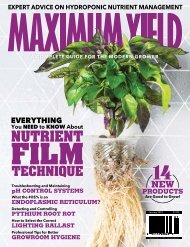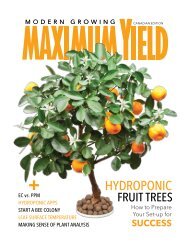Maximum Yield Modern Growing | Canadian Edition | May June 2017
In this issue of Maximum Yield, we cast a wide net to bring you the best and latest information possible to help you get started growing your own food. From the basics like cleaning your equipment to the best methods for preparing your plants to live outdoors, to more advanced topics like lighting and nutrient delivery, there is something in this issue for all levels of grower.
In this issue of Maximum Yield, we cast a wide net to bring you the best and latest information possible to help you get started growing your own food. From the basics like cleaning your equipment to the best methods for preparing your plants to live outdoors, to more advanced topics like lighting and nutrient delivery, there is something in this issue for all levels of grower.
Create successful ePaper yourself
Turn your PDF publications into a flip-book with our unique Google optimized e-Paper software.
Spectral distribution<br />
will have significant<br />
implications on the<br />
growth and development<br />
of plants, along with the<br />
overall energy efficiency<br />
of a lighting system.<br />
However, the amount of<br />
PAR delivered to a crop<br />
is an equally (if not more)<br />
important metric to focus<br />
on. Photosynthetic photon<br />
flux and photosynthetic<br />
photon flux density (PPFD)<br />
are two metrics used to<br />
measure the amount of PAR.<br />
Photosynthetic<br />
Photon Flux<br />
This measures the total<br />
amount of PAR that is<br />
produced by a lighting<br />
system each second. This<br />
measurement is best taken<br />
using a specialized instrument called<br />
an integrating sphere, which captures<br />
and measures essentially all photons<br />
emitted by a lighting system. The unit<br />
used to express PPF is micromoles<br />
per second (μmol/s). Photosynthetic<br />
photon flux is a very important metric<br />
if you want to be able to calculate<br />
how efficient a light is at converting<br />
electrical energy into photons of<br />
PAR. If the PPF of the light is known<br />
along with the input wattage, you can<br />
calculate how efficient a horticulture<br />
lighting system is at converting<br />
electrical energy into PAR. However, it<br />
is important to note that PPF does not<br />
tell you how much of the measured light<br />
actually arrives to the plant canopy.<br />
While it’s nice to know the PPF of a<br />
lighting system, PPF alone is often<br />
useless information to a grower.<br />
Photosynthetic Photon<br />
Flux Density<br />
Photosynthetic photon flux density<br />
measures the amount of PAR that<br />
actually arrives at the plant, or, as a<br />
scientist might say, “the number of<br />
photosynthetically active photons<br />
that fall on a given surface each<br />
second.” PPFD is a spot measurement<br />
of a specific location on your plant<br />
canopy, and it is measured in<br />
micromoles per square metre per<br />
second (μmol/m 2 /s). If you want to<br />
find out the true light intensity of a<br />
fixture over a designated growing<br />
area, it is important that the average<br />
of several PPFD measurements at a<br />
defined height (typically, the top<br />
of your crop canopy) are taken.<br />
Lighting companies that only<br />
publish the centre point PPFD<br />
directly below their lighting fixture<br />
grossly overestimate the true light<br />
intensity of a fixture. A single<br />
measurement does not tell you<br />
much, since horticulture lights are<br />
generally brightest in the centre,<br />
with light levels decreasing as<br />
measurements are taken towards<br />
the edges of a coverage area. It is<br />
easy for lighting manufacturers to<br />
manipulate PPFD data if buyers<br />
are not educated on the proper<br />
way to measure PPFD. To ensure<br />
you are getting accurate PPFD<br />
values over a defined growing<br />
area, the following needs to be<br />
published by the manufacturer: the<br />
maximum, minimum, and average<br />
measurement; measurement<br />
distance from light source (vertical<br />
and horizontal); number and<br />
location of measurements; and the<br />
min/max ratio if only an average<br />
PPFD is provided.<br />
“PPF” is commonly used to describe<br />
PPFD by academics in peerreviewed<br />
journals, and debate<br />
continues among plant scientists<br />
and engineers on which usage<br />
of the term is correct. One way to<br />
avoid ambiguity when reading a<br />
Fig. 2: Spectral distribution chart of an HPS lighting system.<br />
“ Understanding<br />
the correct<br />
metrics to use<br />
will not only allow you to<br />
make better purchasing<br />
decisions of horticulture<br />
lighting systems, but will<br />
ultimately make you a<br />
better grower. ”<br />
journal article or product brochure is<br />
to focus on the unit of measurement.<br />
If the unit includes m 2 , then the unit<br />
is referring to the light intensity at<br />
the surface of a plant canopy (PPFD).<br />
If m 2 is not included, then the unit is<br />
referring to the total PAR emitted from<br />
a light source (PPF). Understanding<br />
the correct metrics to use will not only<br />
allow you to make better purchasing<br />
decisions of horticulture lighting<br />
systems, but will ultimately make you<br />
a better grower.<br />
grow cycle<br />
43


















